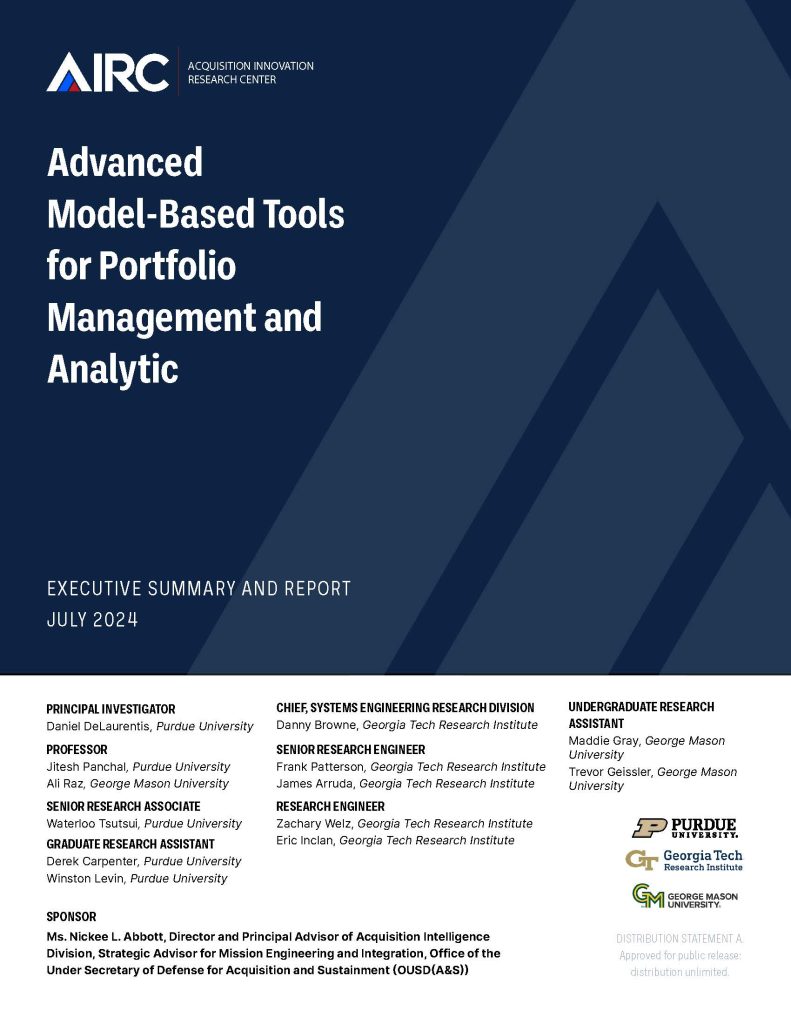Research Reports
Advanced Model-Based Tools for Portfolio Management and Analytic
PUBLIC RELEASE
October 2024
COMPLETED
July 2024
AUTHORS: Dr. Daniel A. DeLaurentis1, Dr. Jitesh H. Panchal1, Dr. Ali Raz3, Dr. Waterloo Tsutsui1, Mr. Danny Browne2, Dr. Frank Patterson2, Dr. James Arruda2, Dr. Zachary Welz2, Dr. Eric Inclan2, Mr. Derek Carpenter1, Mr. Winston Levin1, Ms. Maddie Gray3, Mr. Trevor Geissler3
PURDUE UNIVERSITY 1, GEORGIA TECH RESEARCH INSTITUTE 2, GEORGE MASON UNIVERSITY 3
SPONSOR: Office of the Under Secretary of Defense for Acquisition and Sustainment
Effective portfolio management is essential in defense acquisition to align investments with strategic goals, optimize resources, and enhance capabilities. It ensures that investments address emerging threats and budget constraints while maintaining technological superiority and readiness. The Department of Defense’s (DoD) use of Integrated Acquisition Portfolio Review (IAPR) processes to conduct cross-functional reviews of acquisition portfolios is an important component in an overall Capabilities Portfolio Management (CPM) philosophy. The AIRC WRT-1081.7.5 team, consisting of Purdue University, Georgia Tech Research Institute (GTRI), and George Mason University (GMU), has collaborated to advance IAPR tools. Building on pilot tools developed in 2022 under AIRC WRT-1049.5 research, the team enhanced portfolio optimization algorithms and explored defense acquisition platforms like the Defense Acquisition Visibility Environment and Advana to improve transparency, with the ultimate goal of enhancing the effectiveness of the IAPR processes and tools.
Purdue’s research has advanced a portfolio management tool for IAPRs. Key achievements include enhancing the Robust Portfolio Optimization (RPO) tool with new optimization algorithms to better evaluate complex mission design impacts on the System of Systems. Purdue successfully converted RPO scripts from MATLAB to Python, incorporating optimization methods such as Bertsimas-Sim, Conditional Value-at-Risk, and Robust Mean-Variance Optimization. These advancements are designed to provide decision-makers with robust IAPR tools for portfolio optimization.
GTRI’s research focused on strengthening support for IAPRs by organizing human and technical data. The team analyzed existing documentation and data to create a comprehensive composite document that details the IAPR process and its alignment with mission engineering. GTRI developed an initial data model that integrates programmatic and mission engineering concepts and created a proof-of-concept tool called IAPR Data Exploration & Analysis Tool for data exploration, analysis, and visualization.
GMU’s research explored integrating various levels of autonomy into Systems of Systems using a search and rescue (SAR) mission use case. GMU developed a framework to assess the effects of different levels of autonomy on SAR operations by using model-based systems engineering (MBSE). This approach demonstrated the potential for improved operational efficiency and highlighted significant enhancements in effectiveness through strategic integration of autonomy.
This report details the research findings that are considered Phase 1. A proposed second phase of research (Phase 2) would build on Phase 1’s findings. Specifically, Purdue would propose to lead Track 1 (IAPR tool development), while GTRI would lead Track 2 (IAPR tool experimentation). In particular, Purdue would integrate RPO with MBSE software and explore hybrid RPO approaches in order to test applicability beyond IAPRs to other CPM activities. GTRI would experiment with the tools for IAPR support while working with stakeholders to understand needs and assess ontologies for future semantic technology adoption. GMU would refine the autonomy model, add operational data, and support a more model-based IAPR process.






